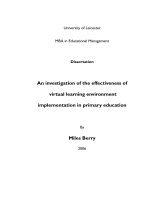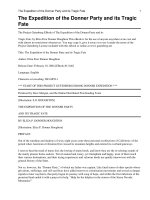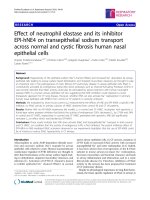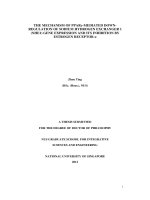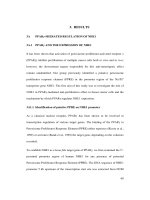Ab initio and DFT investigation of the mechanism and hydration pattern of sialidase and its inhibitor
Bạn đang xem bản rút gọn của tài liệu. Xem và tải ngay bản đầy đủ của tài liệu tại đây (4.57 MB, 209 trang )
AB INITIO AND DFT INVESTIGATION OF THE MECHANISM AND
HYDRATION PATTERN OF SIALIDASE AND ITS INHIBITORS
KRISHNAN CHANDRASEKARAN
NATIONAL UNIVERSITY OF SINGAPORE
2010
AB INITIO AND DFT INVESTIGATION OF THE MECHANISM AND
HYDRATION PATTERN OF SIALIDASE AND ITS INHIBITORS
KRISHNAN CHANDRASEKARAN
M.S. (By Research) Chemistry
National University of Singapore
A THESIS SUBMITTED FOR THE DEGREE OF DOCTOR OF PHILOSOPHY
DEPARTMENT OF CHEMISTRY
NATIONAL UNIVERSITY OF SINGAPORE
2010
DEDICATED
TO
LORD SRI KRISHNA
i
ACKNOWLEDGEMENT S
I pay my respectful thanks from the bottom of my heart to Lord Sri Savitri and Lord
Sri Gayatri for illuminating, guiding and inspiring my intellect to complete this research
study successfully.
I wish to pay my sincere thanks to my supervisor Associate Professor Ryan, P.A.
Bettens for his patronage, supervision, gentle conduct and guidance to complete this
course.
I am ever grateful for financial assistance provided by the National University of
Singapore, Dept. of chemistry to complete this course and for fulfilling my goal of
higher research study in chemistry.
I am thankful to my friend Dr. Sanjiv Kumar Yadav, Research Fellow, Department of
Physiology, NUS for his constant support and ceaseless encouragement to finish this
course.
I owe to my dearest and noble friend Mr. B.T.S Ramanujam, Research Scholar,
National Chemical Laboratory, Pune, India for his ceaseless impetus to complete this
course.
I sincerely thank Mr. Karthik Sekar, Graduate Student for his crucial support to
complete this work.
Also I extend my thanks to my friends Ms. Tan Amelia and Dr. T. Velmurugan for
their encouragement to complete this course.
I am ever grateful to my beloved parents and my siblings for their profound love,
hospitality, prayers for my health and education, faith, ceaseless support and
encouragement to complete this research study and for their dedication to send me the
overseas.
I wish to express my deep sense of indebtedness to Ms. Inthrani Raja Indran, Research
Scholar, Department of Physiology, NUS for her cardinal role to complete this research
study.
K. CHANDRASEKARAN
ii
TABLE OF CONTENTS
Chapter 1 General Introduction 1
Chapter 2 Theoretical Methodology 6
2.1 Introduction 6
2.2 The Schrodinger Equation 8
2.2.1 Born Oppenheimer Approximation 9
2.2.2 The One-Electron Approximation 11
2.2.3 The LCAO approximation 12
2.2.4 Approximate methods used to solve Schrodinger Equation 13
2.2.5 Variation Method 13
2.3 Perturbation Theory 13
2.4 Hartree-Fock Method 14
2.4.1 Roothan-Hall Method 17
2.4.2 Restricted Hartree Fock Method 18
2.5 Electron Correlation 19
2.5.1 Moller-plesset Method 19
2.6 Density Functional Theory (DFT) 20
2.6.1 Local Density Functional Theory (DFT) 23
2.6.2 Gradient Corrected Methods 23
2.6.3 Hybrid DFT Methods 24
2.7 Solvation Models 24
2.7.1 Solvent\solute descriptor models 25
2.7.2 Statistical Model 25
2.7.3 Molecular Simulations 25
2.7.4 Polarizable continuum model 25
iii
2.7.5 Conductor like PCM (CPCM) model 26
2.7.6 Cluster Continuum solvation model 27
2.8 Basis Set 29
2.8.1 Minimal Basis Set 31
2.8.2 Split Valence Basis Set 31
2.8.3 Polarized Basis Set 32
2.8.4 Diffuse Basis Set 32
2.8.5 High Angular Momentum Basis Set 33
Chapter 3 Catalytic Mechanism of Sialildase enzyme 34
3.0 Introduction 34
3.1 Method of Calculation 35
3.2 Results and Discussion 36
3.3 Catalytic Path Step – II 37
3.4 Catalytic Path Step – III 37
3.5 Catalytic Path Step – IV 38
3.6 Catalytic Path Step – V 39
3.7 Catalytic Path Step – VI 40
3.8 Catalytic Path Step – VII 41
3.9 Catalytic Path Step – VIII 42
3.9.1 Conclusion 44
Chapter 4 Explicit cluster continuum investigation of sialyate compounds 45
4.1 Introduction 45
4.2 Method of Calculation 46
4.2.1 Solvation free energy 47
4.2.2 Gibbs Free Energy 48
iv
4.3 Results and Discussion 49
4.3.1Explicit cluster continuum solvation analysis of sialyate-guandino complex 49
4.4 Cluster continuum studies of sialosyl cation complexes 54
4.5 Explicit cluster continuum solvation analysis of sialyate anion 59
4.6 Cluster continuum solvation analysis of sialyl zwitter ion 63
4.9 Conclusion 72
Chapter 5 Cluster continuum solvation analysis of sialidase inhibitors 73
5.1 DANA Complex 73
5.2 Results and Discussion 74
5.2.1 Cluster continuum solvation analysis of DANA-guandino complex 74
5.3 4-Amino-DANA complex 78
5.3.1 Results and discussion 79
5.4 Solvation analysis of 4-guandino-DANA complex 83
5.4.1 Results and Discussion 85
5.5 Tamiflu-guandino complex 89
5.5.1 Results and Discussion 90
5.6 BCX-guandino complex 94
5.6.1 Results and Discussion 95
5.7 Cluster continuum investigation of anionic substrates 99
5.7.1 Solvation analysis of DANA anion 99
5.7.2 Solvation analysis of 4-amino-DANA anion 103
5.7.3 Cluster continuum solvation analysis of 4-guandino-DANA anion 107
5.7.4 Solvation analysis of tamiflu anion 111
5.7.5 Cluster continuum solvation analysis of BCX anion 115
5.8 Conclusion 130
v
Chapter 6 Effect of hydration on the binding affinity of the substrate 131
6.1 Introduction 131
6.2 Method of Calculation 131
6.3 Results and Discussion 131
6.3.1 Sialyate Complex 131
6.4 Binding affinity of DANA as a function of water molecules 133
6.5 Binding analysis of 4-amino-DANA as a function of water molecules 135
6.6 Binding affinity of 4-guandino-DANA 136
6.7 Investigation of binding affinity of tamiflu 138
6.8 Analysis of binding affinity of BCX as a function of water molecules 140
6.8.1 Binding affinity of sialosyl cationic complex 142
6.9 Conclusion 151
Chapter 7 Effect of substituents on the binding affinity of substrates 153
7.1 Introduction 153
7.2 Effect of C4 substituents on the binding affinity of DANA 153
7.2.1 Effect of C4 substituent in solvent phase 156
7.3 Effect of C7 substituents on the binding affinity of DANA 157
7.4 Effect of C7 substituent of DANA in solvent phase 160
7.5 Effect of C7 substituents on the binding affinity of N-DANA 161
7.5.2 Binding affinity of C7 substituent of N-DANA in solvent phase 164
7.6 Effect of C7 substituents on the binding affinity of 4-guandino-DANA 165
7.6.1 Binding of C7 substituents of guandino-DANA in solvent phase 168
7.7 Effect of C12 substituents on the binding affinity of tamiflu 169
7.7.2 Effect of C12 substituents on the binding affinity in solvent phase 173
7.8 Effect of C6 substituents on the binding affinity of tamiflu 174
vi
7.9 Conclusion 182
Conclusion 183
References 186
vii
LIST OF TABLES
Chapter 4
Table I Solvation free energy and hydration energy of sialyate-guandino complex 68
Table II Solvation free energy and water binding energies of sialosyl cationic complex 69
Table III Solvation free energy and water binding energy of sialyate anion 70
Table IV Solvation free energy and hydration energy of sialyl zwitter ion 71
Chapter 5
Table I Solvation free energy and water binding energy of DANA complex 120
Table II Solvation free energy and hydration energy of N-DANA complex 121
Table III Solvation free energy and hydration energy of 4-guandino-DANA complex 122
Table IV Solvation free energy and water binding of energy of tamiflu complex 123
Table V Solvation free energy and water binding energy of BCX complex 124
Table VI Solvation free energy and water binding energy of DANA anion 125
Table VII Solvation free energy and hydration energy of N-DANA anion 126
Table VIII Solvation free energy and hydration energy of 4-guandino-DANA anion 127
Table IX Solvation free energy and water binding energy of tamiflu anion 128
Table X Solvation free energy and water binding energy of BCX anion 129
Chapter 6
Table I Binding energy of sialyate complex 145
Table II Binding affinity of DANA as a function of water molecules 146
Table III Binding energy of N-DANA as a function of water molecules 147
Table IV Binding energy of 4-guandino-DANA as a function of water molecules 148
Table V Binding affinity of tamiflu as a function of water molecules 149
Table VI Binding affinity of BCX as a function of water molecules 150
Table VII Binding affinity of cationic substrate 151
viii
Chapter 7
Table I Binding energy of C4 substituents of DANA 176
Table II Binding energy of C7 substituents of DANA 177
Table III Binding energy of C7 substituents of 4-amino-DANA 178
Table IV Binding energy of C7 substituent of 4-guandino-DANA 179
Table V Binding energy of C12 substituents of tamiflu 180
Table VI Binding energy of C6 substituents of tamiflu 181
ix
LIST OF FIGURES
Chapter 1
Figure 1 Interactions of DANA inhibitor 4
Chapter 3
Figure 1 Sialosyl cation intermediate 34
Figure 2(a)-2(h) Catalytic mechanism of sialidase 36-42
Figure 3 Relative energies of catalytic path (kcal/mol) 41
Chapter 4
Figure 1 Sialyate anion 50
Figure 1(a)-(h) Explicit hydrated structures of Sialyate-guandino complex 50-53
Figure 2 Solvation free energy of sialyate complex function of water molecules 53
Figure 3(a)-3(h) Explicit hydrated structures of cationic complex 54-58
Figure 4, Solvation energy of cationic complex as a function of water molecules 57
Figure- 5(a)-5(h) Explicit hydrated structures of sialyate anion 59-63
Figure 6, Solvation free energy of sialyate anion as a function of water molecules 62
Figure 7(a)-7(h) Explicit hydrated structures of zwitter ion 64-67
Figure 8 Solvation free energy of sialyl zwitter ion as a function of water molecules 67
Chapter 5
Figure 1 Structure of DANA 73
Figure 2 (2a)-2(h) Explict hydrated Structures of DANA-guandino complex 74-77
Figure 3 Solvation free energy of DANA- complex Vs water molecules 77
Figure 4 Structure of 4-amino-DANA anion 78
Figure 4(a)-4(h) Explicit hydrated Structures of N-DANA complex 79-81
Figure 5 Solvation free energy of N-DANA complex Vs water molecules 83
Figure 6 Structure of 4-guandino-DANA 84
x
Figure 6(a)-6(h) Explicit hydrated structure of 4-guandino-DANA complex 85-88
Figure 7 Solvation free energy of 4-guandino-DANA Vs water molecules 87
Figure 8 Structure of tamiflu 89
Figure 8(a)-8(h) Explicit hydrated structures of tamiflu complex 90-92
Figure 9 Solvation free energy of tamiflu complex Vs water molecules 93
Figure 10 BCX Structure 94
Figure 10(a)-10(h) Explicit hydrated structures of tamiflu complex 95-98
Figure 11 Solvation free energy of BCX complex Vs water molecules 97
Figure 12(a)-12(h) Explicit hydrated structures of DANA anion 99-101
Figure 13 Solvation free energy of DANA anion Vs water molecules 106
Figure 14(a)-14(h) Explicit hydrated structures of N-DANA anion 103-106
Figure 15 Solvation free energy of N-DANA anion Vs water molecules 106
Figure 16(a)-16(h) Explicit hydrated structure of 4-guandino-DANA anion 107-110
Figure 17 Solvation free energy of 4-guandino-DANA Vs Water molecules 110
Figure 18(a)-(h) Explicit hydrated structure of tamiflu anion 111-113
Figure 19 Solvation free energy of tamiflu anion Vs water molecules 114
Figure 20(a)-(h) Explicit hydrated structures of BCX anion 115-118
Figure 21 Solvation free energy of BCX anion Vs water molecules 117
Chapter 6
Figure 1 Binding energy of sialyate substrate as a function of water molecules 132
Figure 2 Binding energy of DANA as a function of water molecules 134
Figure 3 Binding energy of N-DANA as a function of water molecules 136
Figure 4 Binding energy of guandino-DANA as a function of water molecules 138
Figure 5 Binding affinity of tamiflu as a function of water molecules 140
Figure 6 Binding energy of BCX as a function of water molecules 141
Figure 7 Binding affinity of cationic complex as a function of water molecules 143
xi
Chapter 7
Figure 1-6, C4 susbstituents of DANA 154-155
Figure 7-14, C7 substituents of DANA 158-160
Figure 15-22, C7 substituents of N-DANA 162-164
Figure 23-29, C7 substituents of guandino-DANA 166-168
Figure 30-39, C12 substituents of tamiflu 170-172
Figure 40-44, C6 substituents of tamiflu 174-175
xii
SUMMARY
This research study addresses the ab initio and DFT investigation of sialidase enzyme mechanism
and hydration pattern of its inhibitor. Effect of substituents at the key functional site of inhibitor
is studied and validated its effect on binding affinity of the various sialidase substrates. Chapter 1
deals with the general introduction of this thesis. Chapter 2, addresses the theoretical
methodology, computational methods, basis sets, fundamental quantum chemistry, solvation
models and the cluster continuum solvation analysis. The cluster continuum analysis delineates
the specific binding effect of explicit water molecules in the functional site of the respective
sialidase substrates. Chapter-3 explains the catalytic path of sialidase enzyme using the ab initio
method. The mechanistic investigation of sialidase enzyme reveals that the enzyme mechanism
proceeds through the carbocation intermediate formation and not by the covalent intermediate.
This structural finding favors the design and development of sialidase inhibitor. Chapter 4,
explains the explicit cluster continuum solvation investigation of sialyate compounds such as
sialyate-guandino complex, sialyate anion, sialososyl cation-guandino complex and sialyl zwitter-
ion.
The investigation divulges that the cluster continuum solvation free energy of sialyate complex
and sialyate anion increases as a function of water molecules and thus invalidates the specific
binding of explicit water molecules in the functional site of sialyate complex and its anion.
However, the cluster continuum solvation free energy of sialosyl cationic complex and sialyl
zwitter ion decreases as a function of water molecules until the explicit trihydrated structure and
this validates the presence of water molecules in the functional site of sialosyl cationic complex.
Hence, presence of water molecule is confirmed near the carboxylate oxygen, C4 hydroxyl group,
C2 carbon, C7 hydroxyl group and carbonyl oxygen of the sialosyl cation intermediate.
Chapter5, deals with the cluster continuum solvation analysis of sialidase inhibitors such as
DANA, 4-amino-DANA, 4-guandino-DANA, tamiflu and BCX. The solvation analysis indicates
xiii
that the cluster continuum solvation free energy of pyranose cyclohexane derivatives such as
DANA, N-DANA and 4-guandino-DANA increases as a function of the water molecules and
therefore invalidates the specific binding of explicit water molecules in the functional site of the
respective substrates. The presence of polarized C–O link in the cyclohexane derivatives causes
poor specific binding of explicit water molecules. Cluster continuum solvation analysis of
tamiflu complex indicates that the solvation free energy increases as a function of water
molecules and thus invalidates the specific binding of explicit water molecules in the functional
site. Cluster continuum solvation analysis of tamiflu anion indicates that the solvation free
increases as a function of water molecules except monohydrated structure. Hence, presence of
water molecule is validated in the monohydrated structure of a tamiflu anion. The solvation
analysis of the BCX inhibitor shows that the cluster continuum solvation free energy of BCX
complex and its anion decreases as a function explicit water molecules until the tri-hydrated
structure and thereafter it increases as a function of water molecules.
Hence, the presence of water molecules is validated in the explicit tri-hydrated structure of BCX
complex. Chapter 6 addresses the effect of explicit water molecules on the binding affinity of the
sialidase substrates. The investigation of explicit water molecules on the binding affinity of the
sialyate complex, DANA-complex, N-DANA complex, 4-guandino-DANA complex and tamiflu
complex indicates that the binding affinity of the sialidase substrates decreases as a function of
water molecules. Hence, it authenticates that the explicit hydration is detrimental to the binding
affinity of the sialidase substrates. The binding analysis of BCX inhibitor implies that the
binding affinity decreases as a function of explicit water molecules except the explicit dihydrated
structure. Hence, dihydrated structure of BCX will be used in the design of sialidase antiviral
drugs. The effect of explicit hydration on the sialosyl cationic complex reveals that the binding
energy of cationic complex increases as a function of water molecules and hence, this finding will
facilitate the development of sialidase inhibitors. Chapter 7 deals with the effect of substituents
on the binding affinity of the sialidase substrates. The effect of C4 substituent on the DANA
xiv
discloses that the methoxy and amino group increases the binding affinity of DANA. Similarly
the analysis of C7 substituent on the binding affinity of DANA reveals that the guandino at the
C7 position drastically enhances the binding affinity of DANA. Effect of C7 substituent on N-
DANA reveals that the amino, methoxy and thiol at the C7 position of DANA increases the
binding affinity. The analysis of C7 substituent on the 4-guandino-DANA indicates that the
amino, methoxy and methyl group provides a higher binding affinity. Effect of C12 substituent
on tamiflu discloses that the methyl and ethyl group influences the binding affinity. The analysis
of C6 substituent on tamiflu indicates that none of the susbtituents increases the binding affinity
and hence, amino group at the C6 position is the best substituent of tamiflu. In summary, the
substituent with a higher binding affinity will assist in the development of sialidase inhibitors.
1
CHAPTER 1
INTRODUCTION
1.1 INTRODUCTION
Conserved water molecule in a protein plays a central role in predicting protein structures and it
allows opening insights into the field of drug design. Hence the study of molecular hydration and
interaction of hydrated water with macromolecules, will establish a new era in chemical,
biological and enzyme catalytic process
1
. The advent of sophisticated experimental tools and
theoretical methods, leads to the substantial studies on molecular hydration and it is reported in
the recent literatures
2,3
. The hydrogen bond has considerable importance on research in chemistry
and biology. It plays a vital role in elucidating the molecular conformation, crystal structure and
protein structures
4
. Scientific reports have proved that the water in macromolecules has a unique
property and its specificity has a critical impact on the biological activity of DNA, protein and
enzyme
5
. In addition the hydrogen bond formed by the water molecules affects the intramolecular
proton transfer in biological process.
On account of this significance, the theoretical study of hydrogen bonded systems is crucial for
deeper understanding of the protein interactions and enzymes and this eventually provides a
rationalization of the structure
6
. Thus the interaction of proteins with the surrounding water
molecule has become significant research area in protein sciences at molecular level
7,8
. Mass
spectrometry provides an ideal technique to investigate the hydration studies of biological
compounds at the molecular level. Besides, it discloses the relationship between biomolecular
structures in the solvent and gas phases and the role of water molecules in the bio-molecular
structures.
9
So, the interaction between water and proteins and nucleic acids at the molecular
level are also a topic of a major interest with the ultimate goal of understanding enzymatic and
cellular actions. Next to mass spectrometry, X-Ray crystallography is used to detect the binding
sites, structure and dynamics of water molecules in the proteins. In addition, theoretical
2
calculations provides a complementary tool to study the geometries and energetics of ionic
hydrogen bonds in enzymatic reactions and proteins.
10
Hence, explicit solvation analysis of
proteins and biologically important macromolecules will be useful in predicting the internal
binding sites of proteins. Recent review shows that the ion-solvent interactions involve in strong
ionic hydrogen bonded networks and thus it further signifies the role of molecular hydration.
11
Especially in biological studies, the ion-solvation interaction is important in enzyme activity,
protein folding and membrane transport
12
. Water has a dynamic role beyond maintaining the
structure of proteins and biological macromolecules. Although the role of water molecules in
protein folding is improved with limited success; the implicit solvent models accurately
representing protein stability and dynamics suggest that the physics of interaction between
biomolecules and solvent is not yet completely captured. Hence, exploring the dynamics and
structural features of water molecules in the hydration shell and internal cavities will provide key
information to understand the structure of biomolecules and proteins.
Hence, this chapter provides a general introduction of explicit solvation and its specific effect on
the functional sites of sialidase substrates. The literatures are rich with several experimental as
well as theoretical works addressing the problem of molecular hydration. Chapter 2, addresses
the electronic structure methods, geometry optimization, frequency calculation, density functional
Method (DFT), solvation models and cluster continuum solvation method employed in this thesis.
It also provides a brief description of basis sets. Chapter 3, focuses on the catalytic mechanism of
sialidase enzyme and the structure of the cationic intermediate. Sialic acid, the natural ligand of
sialidase, plays a key role in enzyme catalysis and in the design of sialidase inhibitors. Explicit
solvation analysis of sialosyl cation provides precise information about the water mediated
catalytic path. Functional and structural information about sialidase has a significant effect on the
discovery of sialidase inhibitors.
13
The sialidase is involved in the cleavage of terminal sialic
acid from ketosidic linkage of adjacent carbohydrate unit during its catalytic path and promotes
the release of progeny virus from the infected cell
14
and thus proliferates the viral infection to all
3
the cells. This disease had a strong impact on the whole human population and caused severe
respiratory illness and death from 30 million to 50 million people
15
. The enzyme mechanism
appears to proceed via the formation of sialosyl cation intermediate with a distorted half-chair
conformation
16
and its structure is shown in chapter 3. The formed cationic intermediate is
hydrolytically released as sialic acid. While the detailed mechanism of catalysis is not yet known
precisely; it has been proposed that it proceeds predominantly by a carbocation intermediate and
perhaps by a covalent intermediate. The present ab initio investigation shows that the catalytic
mechanism proceeds through the sialosyl cation intermediate without forming a covalent
intermediate. Chapter 4, addresses the cluster continuum solvation investigation of the sialyate-
guandino complex, sialyate anion, sialosyl-cation guandino complex, and sialyl zwitter ion. The
focus here is to obtain molecular level insights of explicit water molecules in the hydration
process. Detailed analysis of molecular hydration has been carried out for the sialyate
compounds to unearth the best hydration pattern and the specific binding of explicit water
molecules. Currently, two different approaches are commonly available for the treatment of
solvation in computational modeling of biomolecules.
First the solvent effect can be described in explicit solvent models using the limited number of
explicitly simulated water molecules around the protein-ligand complex and its components
17
and
then theoretical calculation were performed to compute the solvation energy. This model is
clearly explained in chapter 4. Neuraminidase (NA) is a major surface glycoprotein of influenza
virus that possesses an enzymatic activity essential for viral replication and infection
18
and sialic
acid is the natural ligand of the neuraminidase. The active site is highly conserved and presents a
rigid catalytic centre
19
. The use of the explicit solvation treatment is valuable to gain insight into
the discrete role of water molecule in folding and hydrogen bonding in the vicinity of sialidase
active sites. This solvation treatment will predict better water binding sites of ligands and the
burial of water molecules in the vicinity of functional sites. Besides, it helps to identify and
characterize the binding sites where water improves the overall binding. Theoretical and
4
computational approaches can aid and complement the experimental efforts to unearth the
presence of water molecules in the cavities of biological macromolecules. Internal water sites in
proteins are highly conserved
20
and hence, the introduction of explicit hydrated water molecule
may improve the prediction of protein structures. Hence chapter-4 will elaborate the explicit
solvation analysis of sialyate compounds to determine the presence of water molecules in the
functional site. Chapter 5, addresses the cluster continuum solvation analysis of sialidase
inhibitors such as DANA, N-DANA, 4-guandino-DANA and tamiflu. Cluster continuum
solvation analysis of sialidase inhibitors is performed in both anionic and complex form with the
protonated methyl guandino. The explicit hydrated structures were formed for each substrate by
adding explicit water molecules near the functional sites. A hydrated structure with the lowest
water binding energy will indicate the specific binding of explicit water molecules in a functional
site of the substrate. The substrates such as DANA, N-DANA and 4-guandino-DANA is based
on the cyclohexane pyranose derivatives whereas tamiflu is based on the carbocyclic structure
with no oxygen in the ring and its structures are clearly depicted in chapter 5. Chapter 6, explains
the effect of explicit water molecules on the binding affinity of the substrate. Neuraminidase
bound to the DANA in four binding pockets
21
viz (a) a carboxylic acid group (b) an acetamide
group (c) the glycerol hydroxyl group (d) the fourth C4 hydroxyl group and it is shown in figure1.
Figure-1, Schematic interactions of DANA inhibitor (X=OH, Y=OH)
5
It is clear from the figure-1 that the binding of carboxylic group with the triad arginine is the most
powerful binding pocket. Hence, the binding affinity of sialidase substrate is calculated in a
highly simplified version by considering the binding affinity between the carboxylic group and
the protonated methyl guandino. Protonated methyl guandino is a model of the arginine amino
acid residue employed in this study. The binding affinity of sialyate complex, DANA, N-DANA,
4-guandino-DANA, tamiflu and BCX inhibitors were investigated as a function of explicit water
molecules in chapter 6. The binding affinity of sialosyl cationic complex is also investigated in
this section and the cationic complex differs from the other neutral complexes. The sialidase
substrate which increases the binding affinity as a function of water molecules will assist in the
development of sialidase inhibitors. Chapter 7, deals with the effect of substituents on the
binding affinity of the sialidase inhibitors. The substituents were introduced at the C4 and C7
position of DANA to evaluate its binding affinity. The substituents such as methyl, methoxy,
thiol, chlorine, fluorine, guandino, trifluoro carbon and amino group were evaluated for the
binding affinity. The effects of substituents were also performed at the C7 position of 4-amino-
DANA and 4-guandino-DANA to evaluate its binding affinity. The substituent with a higher
binding affinity will aid in the development of new DANA derivative with an enhanced binding
affinity. The effects of substituents were also carried out at the C12 and C6 position of tamiflu to
evaluate its binding affinity. Substituent with a higher binding affinity of tamiflu will assist in the
development of potent sialidase antiviral inhibitors.
6
CHAPTER 2
THEORETICAL METHODOLOGY
2.1 INTRODUCTION
Ab initio molecular orbital theory is aimed at determining the electronic energies, wave functions
of atoms and other properties of molecules. It relies on the fundamental laws of quantum
mechanics, mathematical transformation and approximation techniques to solve the Schrödinger
equation
22
. Computational chemistry simulates chemical structures and reactions numerically,
based on the fundamental laws of physics. It simplifies the researchers to study chemical
reactions by performing calculations on computers rather than by examining reactions in the
laboratory. A few methods can be used to examine not only stable intermediate, but also transient
intermediates and critical transition states. In this way quantum chemical calculations provide
key information about molecules and reactions, which is impossible to obtain through
observation. Hence, quantum chemistry is a vital adjunct to the experimental studies
23
. There are
three broad areas within computational chemistry dedicated to the study of molecular structures
and their energetics.
(a) Molecular mechanics
(b) Electronic Structure theory
(c) Density functional theory
These three theoretical methods have been employed to perform energy calculation, geometry
optimization and vibration frequency calculation. Molecular mechanics is an empirical method
which, neglects the explicit treatment of electrons and its principle is based on the laws of
classical physics to predict the structures and chemical properties of molecules. Therefore,
molecular mechanics calculations fail to solve energetic problems such as bond breaking or bond
formation, where electronic effects dominate. Contrarily, it performs computations based on the
interactions among the nuclei of the atoms. This makes molecular mechanics method feasible to
study very large and non-symmetric chemical systems such as proteins and biological
macromolecules. However, it has several limitations as well. The commonly used molecular
7
mechanics force fields are AMBER, CHARM, MM
X
and OPLS. Limitations: In molecular
mechanics, no force field can be generally used for all molecular systems of interest. Neglect of
electrons means that molecular mechanics methods cannot treat chemical problems where
electronic effects predominate (e.g) the study of chemical reactions. To surmount the limitations
of explicit treatment of electrons in molecular mechanics methods, quantum chemical methods
have been introduced, and this method treats the electrons by solving the Schrödinger equation
based on the various approximations. The introduced quantum chemical methods have been
classified into semi-empirical methods and Ab initio methods. Semi empirical methods such as
AM1, MINDO/3 and PM3, implemented in programs like MOPAC, AMPAC, HyperChem, and
Gaussian, use parameters derived from experimental data to simplify the computation. It solves
the Schrödinger equation based on the appropriate experimental parameters available for the
particular type of chemical system under investigation. Different semi-empirical methods are
largely characterized by their differing parameter sets. It has its own inherent advantages namely
(i) parameterized from the experimental data or ab initio data on simple organic molecules. (ii) it
reports energies as heats of formation rather than the energy from the isolated nuclei and
electrons. (iii) it is relatively inexpensive compared to the ab initio calculations, and it can be
applied to very large molecular systems.
Limitations: Although it is used for very large systems and has a simplified computational
procedure and has its own limitations. This method is applicable only for the systems where
parameters have been developed for all of their component atoms.
Ab initio methods such as Hartree Fock (HF) and Møller Plesset (MP2) unlike either molecular
mechanics or semi-empirical methods, use no experimental parameters in their calculations.
Instead, their quantum chemical calculation is based on the laws of quantum mechanics–the first
principles referred to the name ab initio and it uses the values of physical constants such as,
(a) Velocity of light (c)
(b) The masses and charges of electrons and nuclei (m
e
)
(c) Planck’s constant (h)
8
Ab initio methods provide high quality quantitative predictions for a large variety of systems, and
it can compute molecules in the ground state, excited state, neutral, ionic and radical forms.
However, ab initio methods are computationally very demanding. Rapid development of
hardware and software at the end of the eighties led to a revolutionary effect on the computational
chemistry in bio-disciplines and as a consequence ab initio techniques are mainly applied to study
the weak molecular interactions of biomolecular complexes. A third class electronic structure
method known as density functional method is introduced recently, which finds greater
applications in computing the properties of molecules at the cost of Hartree Fock. These DFT
methods are similar to ab initio methods in many aspects. Its calculations are based on the
Hohenberg-Kohn theorem according to which, the electron density can be used to determine all
properties of a system under study. DFT methods are attractive because they include the effects
of electron correlation unlike the Hartree Fock which considers this effect only in an average
sense. As the quantum chemical calculation uses the wave function, ψ; the DFT calculations use
the electron density, ρ, to determine the properties of molecules. Thus these methods can,
therefore, provide the benefits of some of the more expensive ab initio methods essentially at the
cost of Hartree Fock calculations.
2.2 THE SCHRöDINGER EQUATION
Ab initio molecular orbital theory is mainly employed for predicting the properties of atomic and
molecular systems. It relies on the fundamental laws of quantum mechanics and uses a variety of
mathematical transformation and approximation techniques to solve the Schrödinger equation.
Electronic structure methods use the laws of quantum mechanics rather than classical physics for
their computations. Quantum mechanics states that the energy and structural properties of a
molecule may be obtained by solving the Schrödinger equation,
Hψ = Eψ 1

